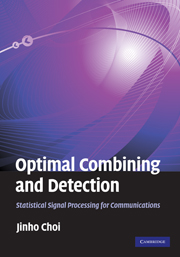Book contents
- Frontmatter
- Contents
- Preface
- List of symbols
- List of abbreviations
- 1 Introduction
- 2 Fundamentals of detection theory
- 3 Fundamentals of estimation theory
- 4 Optimal combining: single-signal
- 5 Array signal processing and smart antenna
- 6 Optimal combining: multiple-signal
- 7 Multiple signal detection in vector space: MIMO detection
- 8 MIMO detection with successive interference cancellation
- 9 Lattice-reduction-aided MIMO detection
- 10 Analysis of LR-based MIMO detection
- Appendix 1 Review of signals and systems
- Appendix 2 A brief review of entropy, mutual information, and channel capacity
- Appendix 3 Important properties of matrices and vectors
- Appendix 4 Lattice theory
- References
- Index
1 - Introduction
Published online by Cambridge University Press: 05 July 2014
- Frontmatter
- Contents
- Preface
- List of symbols
- List of abbreviations
- 1 Introduction
- 2 Fundamentals of detection theory
- 3 Fundamentals of estimation theory
- 4 Optimal combining: single-signal
- 5 Array signal processing and smart antenna
- 6 Optimal combining: multiple-signal
- 7 Multiple signal detection in vector space: MIMO detection
- 8 MIMO detection with successive interference cancellation
- 9 Lattice-reduction-aided MIMO detection
- 10 Analysis of LR-based MIMO detection
- Appendix 1 Review of signals and systems
- Appendix 2 A brief review of entropy, mutual information, and channel capacity
- Appendix 3 Important properties of matrices and vectors
- Appendix 4 Lattice theory
- References
- Index
Summary
Statistical signal processing is a set of tools for dealing with random signals. As a set of tools, statistical signal processing has a broad range of applications from radars and sonars to speech and image processing. There are a number of books on this topic (e.g. (Scharf 1991) and (Orfanidis 1988)). In this book, instead of providing a comprehensive description of statistical signal processing with a broad range of applications, we focus on key approaches for communications. In particular, we attempt to present mainly signal detection and combining techniques in the context of wireless communications.
Applications in digital communications
The main aim of digital communications is to transmit a sequence of bits over a given channel to a receiver with minimum errors. In implementing digital communication systems, however, there are various constraints to be taken into account. For example, the transmission power is usually limited and the complexity of receiver is also limited. With practical implementation constraints including computational complexity, statistical signal processing plays a crucial role in designing a receiver for digital communications. Although there are a number of different roles that statistical signal processing can play, we confine ourselves to two main topics in this book: one is signal detection and the other is signal combining.
Signal detection has been well established as the main topic in communications. However, advances in multiuser detection have opened up a whole new approach for joint detection (Verdu 1998).
Information
- Type
- Chapter
- Information
- Optimal Combining and DetectionStatistical Signal Processing for Communications, pp. 1 - 9Publisher: Cambridge University PressPrint publication year: 2010
